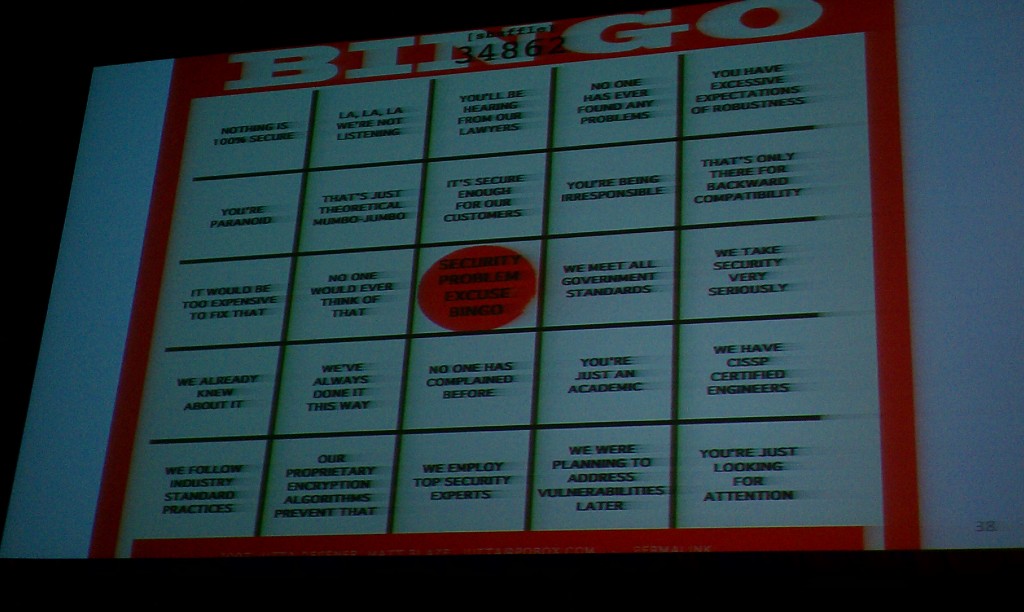Where were we? Oh, yes: The Day of the Router.
(That’d be a good title for a movie. Maybe one about penetration testers. Hmmmm…a pen tester accidentally finds a vulnerability in the wrong system, and the bad guys want to shut him up?)
But I digress.
First in our router trilogy is Michael Coppola‘s “Owning the Network: Adventures in Router Rootkits“. (First link goes to his blog, second link goes to the presentation.)
Coppola has been working on altered versions of firmware for popular routers: “altered” in the sense that the firmware contains useful exploits. (‘But how do you get the firmware on the router?” Well, there are well known cross-site scripting attacks on router configuration pages: as I recall, that was the subject of a DEFCON presentation, but I don’t have time to dig out which one right now. When I get back, I’ll add a link. In addition, how many people leave their router login/password set to defaults? Too many.)
Coppola specifically attacked these routers:
- Netgear WNR1000v3.
- Netgear WGR614v9.
- Belkin FD57230
- Trendnet TEW652BRP 3.2r
And there’s a simple five-step process:
- Profile the firmware image (basically, that means breaking it apart and figuring out what goes where) using a tool such as binwalk from devttys0.
- Extracting out the individual parts (like the router file system: Coppola has a good story about getting unsquash.fs out of Netgear)
- Deploy your exploit payload.
- Repack everything.
- Update the firmware metadata.
How much would you pay for all this? But wait, there’s more! The end result of Coppola’s work is rpef, a framework that automates much of this process. You point it at a firmware image, tell it what exploit you want to use and where to save the modified image…and it generates a new firmware binary for you, ready to upload to your favorite router. Isn’t that a clever cleaver?
(At the moment, rpef only supports a limited number of routers. I suspect if this takes off, the number of supported routers in rpef will expand dramatically.)
Second up on the router hit parade was FX with “Hacking [redacted] Routers“. The [redacted] in this case is Huawei, a large Chinese manufacturer of routers, and the short version of this talk is that their routers are crap. They have no known product security group, they do not issue security advisories, the quality of their code is poor, important ports (SSH, FTP, HTTP) are open by default (and you can access the flash file system by FTP), their OpenSSH implementation is a rewrite from scratch and is broken…
…and it is possible with a simple script to hijack a remote session to the router, there are built-in functions that allow execution of commands from the command line interface with no privilege checks…
….and there’s a heap overflow bug (which the presenters spent a great deal of time explaining) that allows you root on the router. Whew. I think that just about covers it. Luckily, in my opinion, Huawei routers are mostly used in other countries, and I can’t get very upset about those countries having their routers hacked. (What’s the worst case scenario? Less Chinese spam?)
(I can’t find FX’s presentation, and it isn’t on the DEFCON DVD. I’ll link to it when I can find it. Link added 8/1/2012.)
(Interestingly, these first two router panels were so popular, they had to move FX’s panel to a larger room to accommodate the people who wanted to see it. And I think there were still people who didn’t get in.)
Finally, we have “SQL Injection to MIPS Overflows: Rooting SOHO Routers” by Zachary Cutlip. (Link goes to a version of this talk he gave at Black Hat.)
The short summary here is that Cutlip attacked a specific router, the Netgear WNDR3700 v3. This is a highly popular router: as a matter of fact, WCD uses the v2 version of this router (reflashed with DD-WRT firmware) in our home office. One of the interesting aspects of this router is that it has DLNA support, so you can use it to serve things like music and movies. (It has an external USB port for connecting drives.)
As it turns out:
- As part of the DLNA setup, the router runs SQLite. (Apparently, it keeps a database of album art for DLNA device display purposes.)
- You probably already guessed this, but the implementation on the router is vulnerable to SQL injection attacks.
- You can leverage SQL injection and grab the router’s password file, or other arbitrary files from the running router.
- You can also leverage this to force a buffer overflow and run arbitrary code on the device.
Cutlip’s paper contains example Python code for implementing these attacks.
I totally spaced on the “Hacking the GoogleTV” panel and spent the last few hours trolling the dealer’s room for bargains. I did pick up a few things which I may discuss in more detail later. Or maybe not. It depends.
I don’t have a lot to say about the closing ceremonies, with one exception. DEFCON admission this year was $200: during the ceremonies, Dark Tangent stated that they had intended to raise the cost for this year only, to cover all the awesome stuff they wanted to do for DEFCON 20. Their plan was to roll the price back next year, but Dark Tangent found people were asking them how they were going to top this year…
…and he polled the audience to find out if they thought the $200 was a good value for the money. Overwhelming audience sentiment seemed to be that the $200 price tag was not too high, considering what folks got out of DEFCON. And Dark Tangent seems to be serious about getting Kraftwerk to do a concert next year.
I’m going to wrap things here. In the next day or two, I will probably be doing an after-action report, covering Vegas in general and some additional DEFCON odds and ends. I also will be posting updates as I find people’s presentations online, and as folks put them up.
As always, I welcome comments from presenters. I want to say that this year, I did not see a single panel that disappointed me; I liked every single panel I was able to get into.
Also, I want to make note of a thought from dinner tonight with some friends of mine. This may very well be a research idea for next year’s DEFCON.
So we all know how flash memory works, and that if you do repeated write/erase cycles, you’ll wear out your flash. We also know that manufacturers have implemented wear leveling to get around this.
Questions.
- Is it possible to bypass wear leveling on flash devices? Can you write software that does write/erase operations to specific flash memory locations?
- Can you write software that will do repeated write/erase cycles on flash memory devices and make those devices forensically useless? Similar to the old “three pass overwrite” for hard drives?
I don’t know the answers (as I said, this came up at dinner literally two hours after my plane got in) but it seems like a possible area for exploration. I need to go back through my DEFCON archives, as I have a vague memory of someone doing a presentation on flash memory forensics.
(Also, I’m sorry it took so long to get this post up. I finished about 2/3rds of it in the Las Vegas airport, had a very tight connection in Phoenix (literally running to the plane and arriving just seconds before boarding started), got in, wrote most of the last third, and am now going to have a cold beverage and (I hope) about eight hours of sleep.)

